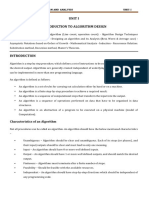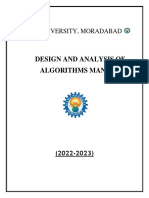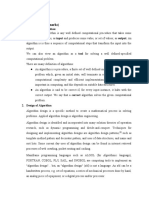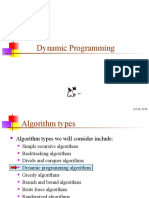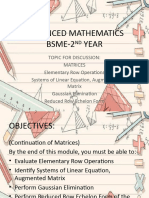Algorithm Paradigms
By
G Suresh Babu
Algorithm
An algorithm is a step-by-step procedure for
solving a problem.
Paradigm
“Pattern of thought” which governs scientific
apprehension during a certain period of time
Paradigms for Algorithm Design
To aid in designing algorithms for new problems, we
create a taxonomy of high level patterns or
paradigms, for the purpose of structuring a new
algorithm along the lines of one of these paradigms.
A paradigm can be viewed as a very high level
algorithm for solving a class of problems
Various algorithm Paradigms
Brute force paradigm
Divide and conquer paradigm
Backtracking paradigm
Greedy paradigm
Dynamic programming paradigm
Brute force paradigm
Brute force is one of the easiest and straight forward
approach to solve a problem
Based on trying all possible solutions
It is useful for solving small–size instances of a
problem
Generally most expensive approach
Examples: Sequential search, factors of number
Divide and conquer paradigm
Based on dividing problem into sub problems
Approach
1. Divide problem into smaller sub problems
Sub problems must be of same type
Sub problems do not need to overlap
2. Solve each sub problem recursively
3. Combine solutions to solve original problem
Examples : Merge Sort, Quick Sort.
Backtracking paradigm
Backtracking is a technique used to solve problems
with a large search space, by systematically trying
and eliminating possibilities
Based on depth-first recursive search
Examples : Find path through maze, eight queens
problem
Finding Path through maze
Path B
Path A
Eight Queens Problem
Find an arrangement of 8 queens
on a single chess board such that
no two queens are attacking one
another.
1) Place a queen on the first
available square in row 1.
2) Move onto the next row,
placing a queen on the first
available square there (that
doesn't conflict with the
previously placed queens).
Greedy paradigm
Optimal solution :A solution which minimizes or
maximizes objective function is called optimal solution
(i.e. BEST solution)
This technique suggest devising an algorithm in no of
steps, each stage depends on a particular input which
gives “optimal solution”.
Examples : 0/1 knapsack, kruskals & prims, counting
money, Dijkstra’s shortest path algorithm
Counting money
Suppose you want to count certain amount of money, using
the fewest possible bills and coins
A greedy algorithm to do this would be:
1. At each step, take the largest possible bill or coin that does
not overshoot
Example: To make 17Rs from 1,5,10 rupee denominations
a)add 10 rupee note
b)add 5 rupee note
c)add two 1 rupee notes
Dynamic programming paradigm
It is also an optimization technique.
Based on remembering past results
Approach
a) Divide problem into smaller sub problems
Sub problems must be of same type
Sub problems must overlap
b)Solve each sub problem recursively
May simply look up solution
c)Combine solutions into to solve original problem
Store solution to problem
Examples: All pairs shortest path, Fibonacci series
Fibonacci series
Fibonacci numbers
– Fibonacci(0) = 1
– Fibonacci(1) = 1
– Fibonacci(n) = Fibonacci(n-1) + Fibonacci(n-2)
Recursive algorithm to calculate Fibonacci(n)
– If n is 0 or 1, return 1
– Else compute Fibonacci(n-1) and Fibonacci(n-2)
– Return their sum
Dynamic programming comes to rescue!
Each computation stores the result in memory for future references.
Instead of calling Fib(n-1) and Fib(n-2) we are first checking if they
are already present in memory or not.
Summary
Wide range of strategies
Choice depends on
Properties of problem
Expected problem size
Available resources
Any queries ???
Thank you





